Reading Comprehension Text and Exercises
Budapest
The Hidden Gem of Europe
Budapest, the capital of Hungary, is one of the best kept secrets in Europe. This beautiful city is divided into two towns by the Danube River. The east side is called Buda and the west side is called Pest. Buda is the hilly side and Pest is the flat side.
While travelers often think of Paris and London as the must-see cities of Europe, they may overlook the historic Ottoman architecture of Buda, the wide boulevards of Pest, and above all the sweeping views of the wide Danube river.
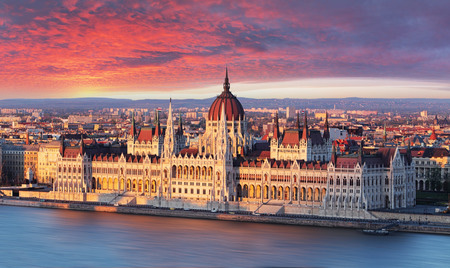
Click Here for Step-by-Step Rules, Stories and Exercises to Practice All English Tenses
A Brief History of Budapest
- Most people agree that Budapest started as the Roman city of Aquinum around 89 AD.
- About 1000 years later, skilled horsemen known as Magyars conquered the city and surrounding area. The Magyars established the nation of Hungary, and the people became known as Hungarians.
- Less than 100 years later, under the reign of King Stephen, the Hungarians accepted the Christian religion.
- Buda became the capital of Hungary in 1361.
- In the 1400s, after fighting against several invasions by the Turks, the country of Hungary was divided among the Ottoman Empire and the Habsburg Empire (a dynasty that ruled over many countries in Europe).
- In the mid-1800s Hungary was united as a nation again and given some self-rule under the Austro-Hungarian Empire. The independent cities of Pest and Buda were joined together to make Budapest in 1873.
- Today, Budapest is not only the political but also the economic and cultural center of Hungary.
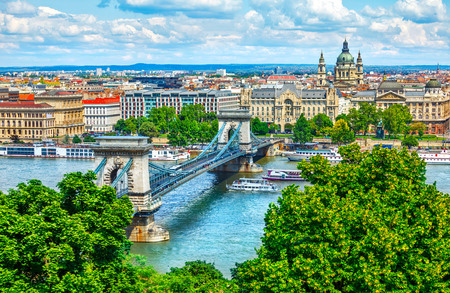
Attractions
Castle Hill
The narrow streets, historic buildings, and spectacular views make Castle Hill a favorite place to wander on the Pest side of the city.
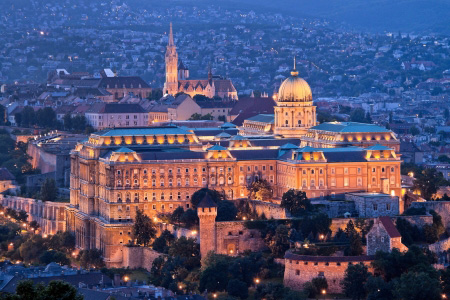
Visitors can see Buda Castle which was the home of Hungarian kings. Buda Castle is now the home of the Budapest History Museum and the Hungarian National Gallery.
Although one can view many works of Hungarian art inside the Gallery, visitors can see important sculptures on the grounds of the castle too.
In the west courtyard, the Matthias Fountain sculpture tells the ancient Hungarian story of how a young girl fell in love with the strong and brave King Matthias when he was out hunting. Across from Matthias fountain, a statue represents Hungary's long history of horse training. The sculpture shows a huge horse standing up on its back legs as a man tries to control the animal.
Another important building in the Castle district is Sandor Palace, the residence, or home, of the president of the Republic. Visitors like to walk by the Palace during the changing of the guard. The soldiers do a difficult set of marching steps to change from one group of guards to the next.
Castle Hill also includes the main square of the old town district of Buda. On one side of the square sits Matthias Church, named after the popular King Matthias. The church dates from the thirteenth century and was the place where new kings were crowned.
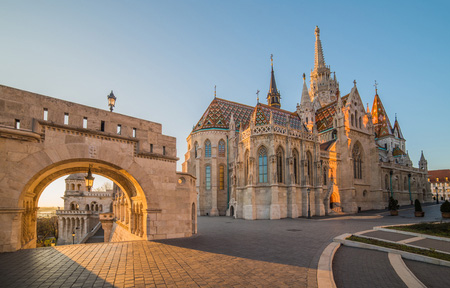
Fisherman's Bastion
Probably the favorite viewing area in Castle Hill is Fisherman's Bastion. A bastion is a strong place that can resist attack. The name may come from a group of fishermen who fought against invaders during the Middle Ages.
The fairy tale architecture includes seven turrets (small pointed towers), statues, fancy balconies, and wide stone steps going from terrace to terrace. Down below one can see sweeping views of the river Danube.
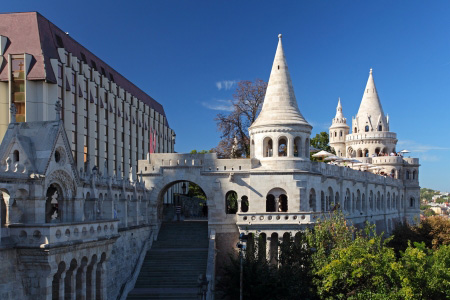
The Chain Bridge
The city's most beautiful bridge, the Chain Bridge, crosses the Danube River and connects the Buda side of the capital city with the Pest side. The cast iron structure of the bridge gives the bridge its popular name. Its official name is the Szechenyi Lanchid.
Opened in 1849, the Chain Bridge was the first permanent bridge across the Danube. At the time it was considered an engineering wonder. Today the Chain Bridge is most famous for its fabulous views of the city and Danube River.
Just like the Brooklyn Bridge has become a cultural icon in the United States, the Chain Bridge is an important part of Hungarian culture. During air plane races in Budapest, daring pilots fly upside down under the bridge. It can also be seen in movies like I Spy and Walking with the Enemy.
Pedestrians, or walkers, are welcome to cross over the bridge and enjoy the views.
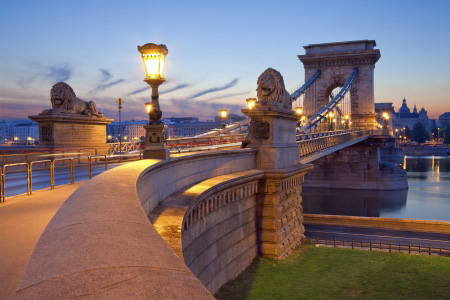
Heroes' Square
Heroes' Square was built in 1896 for the 1000th anniversary of Hungary. It is the largest and most impressive square in Budapest. It is surrounded by the Museum of Fine Arts on the left, and the Hall of Art on the right. Heroes' Square is also a station of the Millennium Underground (the first subway line in Europe).
The Millennium Monument in the middle of the square was built to honor the 1000-year-old history of the Hungarians. It rises to a height of 36 meters (118 feet).
This high column is topped with a statue of the archangel Gabriel, holding a crown in his right hand. According to legend, the archangel appeared to St. Stephen (the first king of Hungary) in a dream and offered him the crown of Hungary.
The base of the column is surrounded by seven statues of strong looking warriors. The statues present the leaders of the Hungarian tribes who settled their people in the area now known as Hungary.
Behind the column there are statues of famous men from Hungarian history and additional statues that symbolize War, Peace, Work and Welfare, and Knowledge and Glory.
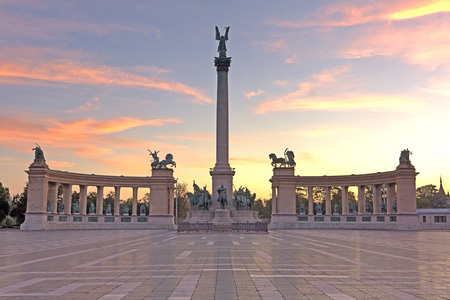
St. Stephen's Basilica
St. Stephen's Basilica is the largest church in Budapest. It is dedicated to Hungary's first king, St. Stephen. It was built over half a century and completed in 1905. It can hold up to 8,500 people!
St. Stephen's Basilica holds impressive classical concerts throughout the year.
The towers of the St. Stephen's Basilica reach high to the sky, which make the it one of the highest points on the Pest side of Budapest.
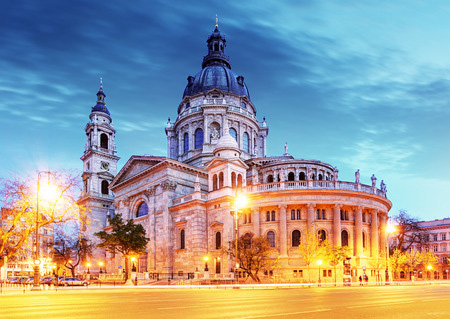
Spas and Coffee Houses
Budapest, the "city of spas," has one of the largest natural hot springs or spa areas in Europe. Going back to Roman times, people soaked in these warm springs for relaxation and healing purposes. The Romans even built their regional capital, Aquinim, in this area west of the Danube River so they could use the hot springs. Some ruins of these Roman baths can still be seen today.
Szechenyi Bath is the most popular spa area. The three outdoor pools and over ten indoor pools date from the 1920s. The Greek and Roman architecture, or building style, along with the steamy pools give a feeling of luxury and calm. Locals and tourists go to swim, soak away their aches and pains, and even play chess on the floating tables.
The tradition of the café goes back hundreds of years in Budapest. The popularity of coffee started with the Turks who came to Hungary in the sixteenth century. By the 1800s there were over 400 coffee houses in Budapest.
Now the tradition continues. The great cafes of the city serve a very strong espresso coffee in china cups (no paper cups here) to crowds of people every day.
Two of the most famous cafes are Gerbeaud and Café Kavehaz. Gerbeaud started in 1858 and is now the largest and most traditional coffee house in the city. Of the many desserts served at Gerbeaud, the sour cherry covered in dark chocolate gets the most praise. Another famous café, Central Kavehaz, has been a gathering place for writers, artists, and musicians since the late 1800s. The inside of Central Kavehaz was restored in 2000 to look like the elegant Viennese café it was during the Austro-Hungarian Empire.

Comprehension Exercises
Vocabulary Questions
- What does "overlook" mean?
- fail to see or notice
- discover something
- go to a place
- What does "established" mean?
- to end something
- to start something
- to view something
- What does "soaked" mean?
- to splash happily in water
- to swim in water
- to become completely wet
- What does "a cultural icon" mean?
- something that everyone knows and likes
- something that makes everyone embarrassed
- something that makes everyone laugh
- What does "praise" mean?
- words that offer advice
- words that show gratitude and thanks
- words that show approval and admiration
Collocation Questions
- Visitors can soak ___________ their pains.
- away
- up
- in
- The church dates ___________ the thirteenth century.
- near
- around
- from
- Budapest is one of the ___________ kept secrets in Europe.
- best
- highest
- most
- A bastion is a strong place that can ___________ attack.
- struggle
- fight
- resist
Wh Questions
- When were the cities of Pest and Buda united to make Budapest?
- 1873
- 89 A.D.
- the 1920s
- Where is Fishermen's Bastion?
- Castle Hill
- Hungarian National Gallery
- Café Gerbeaud
- In what century did coffee become popular in Budapest?
- The first century
- The nineteenth century
- The sixteenth century
- Why did the Romans locate their city of Aquinum on the west side of the Danube River?
- The Romans wanted Aquinum to be near the Chain Bridge.
- The Romans wanted Aquinum to be near Central Kavehaz.
- The Romans wanted Aquinum to be near the hot springs.
- How did the Fishermen's Bastion get its name?
- A group of fishermen defended the building against attack.
- The building is a safe place to fish.
- The Fishermen's Festival is held in the building every September.
Evaluating Statements
- Based on the information in this lesson, which statement is true?
- The Matthias Fountain tells the story of how the king and his men trained a wild horse.
- The Matthias Fountain tells the story of love between a young girl and King Matthias.
- Based on the information in this lesson, which statement is false?
- The Chain Bridge was considered an engineering wonder in 1849.
- Walkers cannot cross the Chain Bridge, only motor vehicles.
True or False?
- Based on the information in this lesson, is the following statement true or false?
"The Magyars, who later became the Hungarians, were skilled horsemen." - True
- False
- Based on the information in this lesson, is the following statement true or false?
"Writers and artists often gather at Buda Castle to drink coffee and share ideas." - True
- False
Answer Key
1. A | 2. B | 3. C | 4. A | 5. C | 6. A | 7. C | 8. B | 9. A | 10. A | 11. A | 12. C | 13. C | 14. A | 15. B | 16. B | 17. A | 18. B
Get Updates, Special Offers, and English Resources
Download your FREE GIFT (the first two chapters of
English Short Stories Book and Workbook)
as soon as you join!

By submitting your email, you consent to receiving updates and newsletters from us and to the sharing of your personal data with third parties for the purposes of sending you communications. We will not spam you. You can unsubscribe at any time. For more information, please see our privacy policy.





